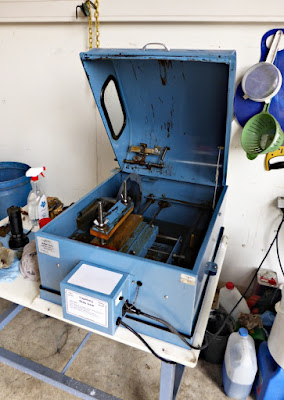Solveig drove us to an observation point near the mouth of the harbor.
The town lay behind us.
Our gaze was directed at a beach carpeted with red knots in breeding plumage, a shorebird of the High Arctic that has been experiencing a population decline.
For a closeup, a shot of the handbook:
A related shorebird, the dunlin, was also visible here.
The observation circle included a memorial to those from this fishing town that have been lost at sea over the centuries.
The next segment of the Ring Road took us near the shore, past deep valleys, and across high bluffs. Here are photos from two of the observation stops.
 |
| A pullout to observe birds and landscape. |
On to the second stop.
 |
| I hope that slope holds. |
 |
Our first stop was near the Langabúð, one of the oldest commercial buildings in Iceland.
We had a chance for a rest stop and a brief leg stretch, and then a local guide joined us to lead a walking tour.
Across the harbor was a pyramid mountain, Búlandstindur, 1069 m high, dominating the fjord (Berufjörður).Our group walked to Steinasafn Auðuns/Audunn's mineral collection.
The owner was there to give us a tour; he didn't speak English but our guide (left below) translated for us.

Adunn is known for disappearing into the mountains and evaluating rocks. Here is some of his polishing equipment for smaller pieces.
Hare bells on the next phase of our walk.
We arrived at the famous egg sculptures.
When the fishing industry packed up and left Djúpivogur a long pipeline that transported the catch to a rendering station was torn up for scrap metal. However, the concrete plinths, or stands, that supported the pipeline remained. What to do with them? Noted local artist Sigurður Guðmundsson designed a series of 34 large granite eggs, each reflecting the shape of the egg of a bird species that nests here. They're all the same size, except for that of the red-throated diver, the official bird of Djúpivogur, which is larger. More info here.
 |
| Unveiled in August 2009 |
Our performance hall.
On the inside, after the concert.
 |
| The door is open to let light in! |
For such a small town there has been a flurry of activity in Djúpivogur. Our guide told us that it's the only small town in Iceland that has seen population growth lately, due to young people returning to start enterprises here.
It was about time for lunch and the afternoon journey. In the next post!


















No comments:
Post a Comment
Comments may not appear immediately as they are moderated by the author to eliminate spam. Please, no commercial links!